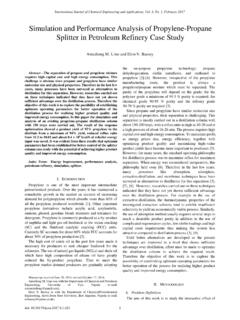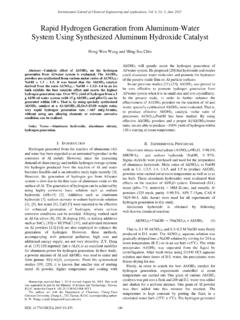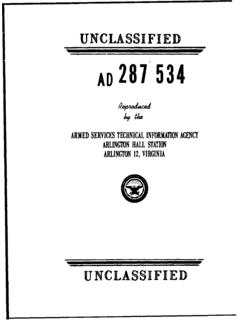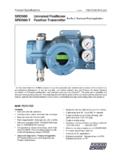Transcription of Study on the Reduction Behaviour of Nickel Doped ...
1 International Journal of Chemical Engineering and Applications, Vol. 7, No. 1, February 2016. Study on the Reduction Behaviour of Nickel Doped Molybdenum Trioxide by Using Carbon Monoxide as Reductant Alinda Samsuri, Fairous Salleh, Tengku Shafazila Tengku Saharuddin, Rizafizah Othaman, and Mohd. Ambar Yarmo good corrosion resistance make them ideally used as an Abstract The Reduction Behaviour of molybdenum trioxide, alloying agent for manufacturing steels, cast irons, and super (MoO3) and Nickel (Ni) Doped MoO3 using carbon monoxide alloys to increase their mechanical strength, hardness, (CO) as reductant was investigated by temperature swiftness and resistance to corrosion and wearing [2].
2 Programmed Reduction (TPR) and characterized by X-ray diffraction (XRD), Brunauer-Emmett-Teller (BET) and As a catalyst, the Reduction Behaviour and the degree of transmission electron microscope analysis (TEM). The Reduction of the molybdenum species were highly important Reduction characteristics of MoO3 to MoO2 were examined up to in such application. The Reduction process of MoO3 is not a temperature 700 C and continued with isothermal Reduction by simple process and involved different mechanism depending 20 vol. % CO in nitrogen. The studies show that, TPR spectra of on various factors such as temperature, concentration of Doped MoO3 slightly shift to a lower temperature as compared Reduction gas used and additives to the MoO3.
3 In general, the to the undoped MoO3 which begins at 630 C. The interaction between Nickel and molybdenum ions leads to this slightly two-stage flow scheme (MoO3 MoO2, MoO2 Mo) is decrease of the Reduction temperature of Ni Doped MoO3. employed in order to minimize the formation of volatile Analysis using XRD confirmed, the addition of Ni enhances the molybdenum species that would be generated at high reducibility of MoO3. By addition of Ni, complete Reduction to temperature required to obtain molybdenum in a single stage MoO2 were take place at only 30 minutes starting of the conversion of the molybdenum precursor [3].
4 Isothermal Reduction at 700 C. Whereas, for undoped MoO3 it Reduction of MoO3 by hydrogen is one of the methods used takes about 60 minutes to completely reduce to MoO2. However, excess of CO brings to the formation of molybdenum carbide to obtain metallic molybdenum of high purity. Many excellent (Mo2C). Based on the results, it is confirmed addition of Ni to reports studying Reduction of MoO3 to Mo with hydrogen MoO3 has a remarkable influence by reducing temperature in have been published [4] [6]. Generally, the two-step the Reduction process. The ability to enhance the reducibility hydrogen Reduction process to produce pure molybdenum involved in MoO3 may be associated to the presence of Nickel powders is well known [7].
5 First stage Reduction occurs in the molybdate, NiMoO4 compound. temperature range of 450 - 650 C, and reduces the input material to MoO2. Second stage Reduction is performed in the Index Terms Carbon monoxide, molybdenum trioxide, Nickel , Reduction . 1000 - 1100 C range, and this process results in molybdenum metal. Nevertheless, hydrogen used as a reducing agent of MoO3 Reduction is expensive. I. INTRODUCTION Carbon is also used to reduce MoO3 at elevated Metallic molybdenum, having a body centered cubic temperature (600 - 1200 C). When metal oxides react with crystal structure with a melting point of 2619 C and a density carbon, one of the reaction products would be gaseous and of g/cm3 [1].
6 Due to superior properties such as could be readily separated from the solid reaction products [8], excellent in mechanical, thermal and electric properties and [9]. This means that the use of carbon as a reducing agent can eliminate the need for an additional process that is a challenging task with reactive metals to separate the reaction Manuscript received February 5, 2015; revised May 20, 2015. This work products. was financially and technically supported by Ministry of Higher Education and Universiti Pertahanan Nasional Malaysia for funding staff scholarships, Therefore, it would be highly desirable to develop an Universiti Kebangsaan Malaysia for funding this project under research alternative process to manufacture molybdenum.
7 Reduction grant number FRGS/2/2013/TK06/UKM/02/3, ETP-2013-066, of MoO3 by using CO as reductant was recommended as an TD-2014-024, BKBP-FST-K003323-2014 and Centre of Research and Innovation Management, Universiti Kebangsaan Malaysia for the alternative process for producing molybdenum. Reduction of instruments facilities. MoO3 to MoO2 by CO was suggested to follow two Reduction Alinda Samsuri is with School of Chemical Science & Food Technology, stages which are shown as equation (1) and (2). However, it is Faculty of Science and Technology, Universiti Kebangsaan Malaysia, 43600 limited of studies to use CO as reductant for Reduction of Bangi, Selangor, Malaysia, and on Study leave from Centre for Defence Foundation Studies, Universiti Pertahanan Nasional Malaysia, Kem Sungai MoO3 to MoO2.
8 Besi, 57000 Kuala Lumpur, Malaysia (e-mail: Fairous Salleh, Tengku Shafazila Tengku Saharuddin, Rizafizah 4 MoO3 + CO Mo4O11 + CO2 (1). Othaman, and Mohd. Ambar Yarmo are with School of Chemical Science &. Food Technology, Faculty of Science and Technology, Universiti Mo4O11 + 3CO 4 MoO2 + 3CO2 (2). Kebangsan Malaysia, 43600 Bangi, Selangor, Malaysia (e-mail: The Reduction of MoO3 to MoO2 is the crucial stage in the production of metallic molybdenum. Reference [10] reported DOI: 16. International Journal of Chemical Engineering and Applications, Vol. 7, No. 1, February 2016.))
9 That the Reduction of MoO3 to MoO2 by using hydrogen reactions were determined by XRD's Bruker AXS D8. consists of two Reduction stages, namely Mo6+ Mo5+ and Advance type. The radiation used was Cu K (40 kV, 40 mA). Mo5+ Mo4+. It seems that during the Reduction of MoO3, to record the 2 diffraction angle from 10 to 80 at MoO3 is firstly reduced to Mo4O11, then continued to MoO2. wavelength ( = nm). For identification purposes of Different reducing agent would give different reducibility crystalline phase composition, diffraction patterns obtained effect. However, other elements are also needed to enhance were matched with standard diffraction data (JCPDS) file.
10 The reducibility of metal oxide. For hydrogen Reduction , other The Brunauer-Emmett-Teller (BET) surface areas of the elements can generally influence MoO3 Reduction by altering catalysts were measured using a Micromeritics ASAP 2010. the reaction sequence by chancing nucleation and growth. instrument after the catalyst was evacuated at 200 C for 4. Moreover, trace elements such as lanthanum, La and yttrium, hours. The TEM analysis was performed using a Philips Y are able to enhance the Reduction rate of MoO3 [10]. CM12 transmission electron microscope with an electron gun Moreover, the addition of Ni to MoO3 can enhance their at 200 kV.










